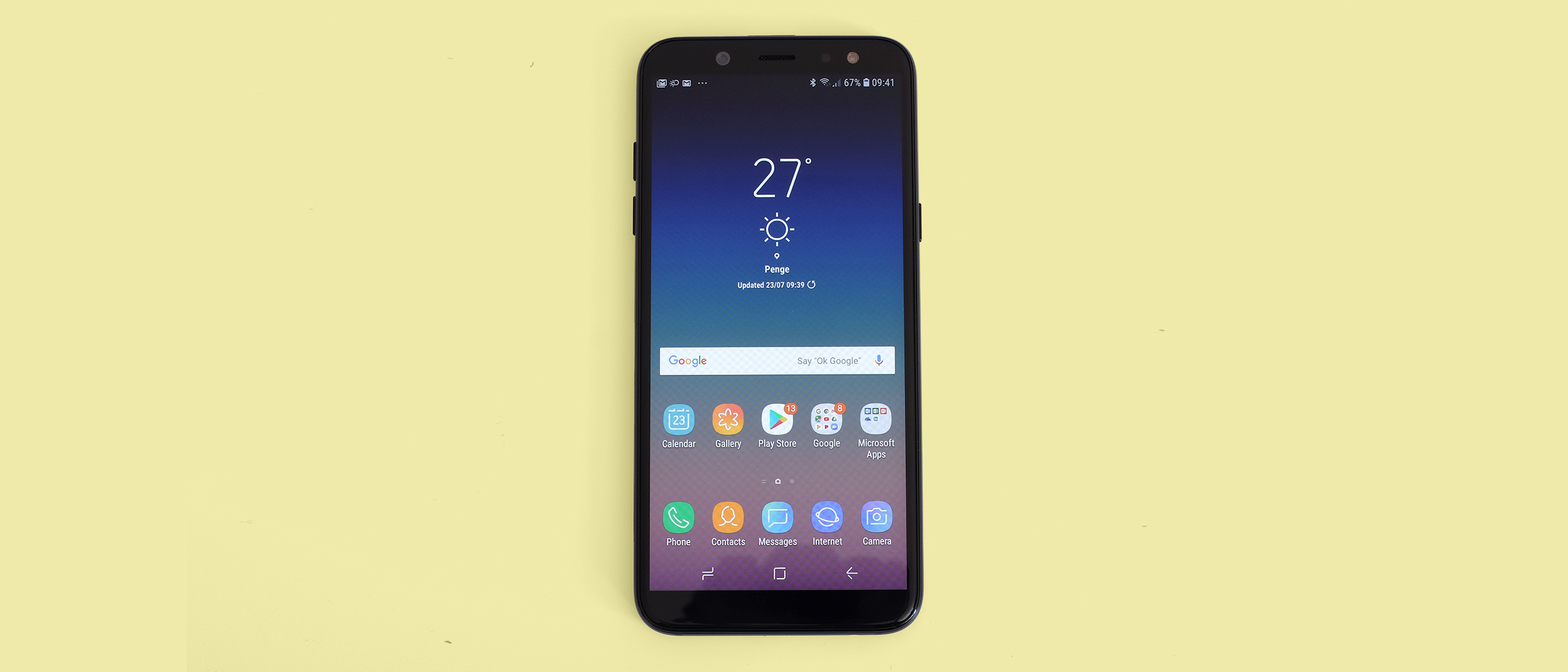Why you can trust TechRadar
Interface
- Android 8.0
- Samsung UI
- Solid enough general performance
The Samsung Galaxy A6 runs Android 8.0 and has Samsung’s own Android interface. This is one of the best custom UIs you’ll find.
It has slick, natural-feeling transitions, is responsive and looks good. How the apps menu works is the main difference between this and the standard Android look. The app drawer is arranged into pages rather than a vertical scroll. You can even get rid of the app drawer entirely if you want.
Bixby Home is the main extra part of the interface. This is a feed of ‘cards’, showing updates from the apps installed on your Samsung Galaxy A6.
It seems fairy pointless unless you’re among the 0.2% of people who haven’t yet found ways to waste time on your phone. But it is also relatively inoffensive. Bixby Home sits to the left of your standard home screen, so doesn’t get in the way.

There are numerous pre-installed apps, including a Samsung suite and Microsoft’s office apps. Samsung Health is the one we tend to use quite a lot when reviewing Samsung phones. This is a fitness tracker app, like Google Fit or Fitbit, that also lets you log your food consumption and even caffeine intake.
The Samsung Galaxy A6 also has a ‘Secure Folder’, which lets you password protect files you don’t want anyone else to see.
On the lighter side, the UI supports themes, like most other interfaces. You have to dig around to find free ones, though. Samsung likes money: who’d have thought?
Movies and gaming
- Mixed performance in games, some bad
- Not the sharpest screen
- Loud speaker with brash treble
The Samsung Galaxy A6 is a reasonable phone for media and games, although not the best you can get for the money. A Motorola Moto G6 Plus offers a larger, sharper screen and a lot more power.
Gaming performance also varies between titles. Asphalt 8 runs very well on the Samsung Galaxy A6, but there’s an obvious unstable frame rate in Minecraft and PUBG. Tencent’s PUBG also runs at ‘Low’ graphics, showing quite how little spare power is available in this phone.
Thanks to the low-resolution PenTile screen, graphics also look less sharp and detailed than in rivals. High color saturation is a benefit for gaming, but we’d prefer better performance and higher resolution.

The same applies for movie-watching. A bigger, sharper screen is better than a smaller, more colorful one.
The speaker is loud at least, but the treble is brash, so while you'll be able to hear things comfortably through it the sound quality isn't always the best.
You have 32GB of storage here, around 22GB of which is accessible. This is a decent amount, but some phones at the same sort of price have 64GB, including the now-discounted Honor 9, Moto G6 and Moto G6 Plus. Some regions are getting a 64GB version of the Galaxy A6, but that of course will push the price up.
Performance and benchmarks
- Poor GPU
- Dated CPU
The Samsung Galaxy A6 has a Samsung Exynos 7870 chipset. It has been used in several Samsung phones including 2017’s Galaxy A3 and 2016’s Galaxy J7. This is the most expensive phone to date to use the CPU.
The Exynos 7870 is an octa-core Cortex-A53 CPU. This is the style and number of cores we expect at the price. As is the 3,530-point Geekbench 4 score. However, its GPU is weak.
It’s the single-core version of the Mali-T830. This is only a third as powerful as the Adreno 508 used by the Moto G6 Plus.
As we saw when playing games, the real-world performance varies depending on context. Asphalt 8 runs great, the GPU a good fit for the action on a lower-resolution screen. However, with games like Minecraft and PUBG, where the number of objects on screen can scale up in a half a second, it struggles.
We also imagine Gameloft may have put extra effort into optimizing Asphalt 8 for this CPU.
If the phone was cheaper this wouldn’t register as a major issue. However, several other phones at the price are much more capable.
Current page: Anything else I should know?
Prev Page Battery life and camera Next Page Verdict and competitionAndrew is a freelance journalist and has been writing and editing for some of the UK's top tech and lifestyle publications including TrustedReviews, Stuff, T3, TechRadar, Lifehacker and others.

